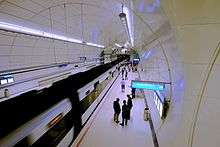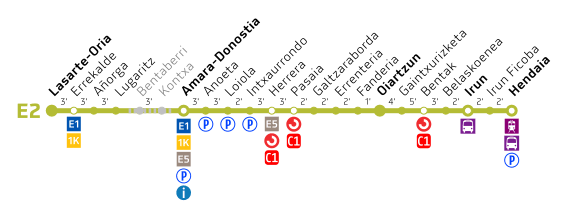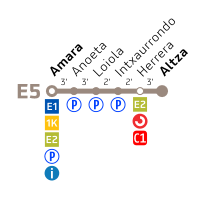Metro Donostialdea
Metro Donostialdea is a rapid transit (metro) system serving the city of San Sebastián and the Donostialdea area, within Gipuzkoa and reaching the city of Hendaye. The line was renamed Metro Donostialdea and converted into an urban rapid transit system in August 2012,[2] and it was previously known as the Topo line ("topo" being Spanish for "mole") and part of the Euskotren Trena commuter rail network. In August 2012 its livery was changed to reflect the new brand, metro donostialdea, and new stations were opened, creating the called "Line 1" and seven new stations are expected to be constructed and opened within the city of San Sebastián to complete the aforementioned first line[3] It is operated by the Basque Railways and it uses meter gauge.
 | |
| Overview | |
|---|---|
| Owner | Basque Railways |
| Locale | Donostialdea (greater area of San Sebastián), Gipuzkoa, Spain |
| Transit type | Rapid transit Commuter rail |
| Number of lines | 2 |
| Number of stations | 21 |
| Annual ridership | 12 million (2018) [1] |
| Website | Official website |
| Operation | |
| Began operation | October 2012 (as Metro Donostialdea, earlier as Euskotren Trena) |
| Operator(s) | Euskotren Trena |
| Technical | |
| System length | 29.8 km |
| Track gauge | 1,000 mm (3 ft 3 3⁄8 in) metre gauge |
| Electrification | Yes |
Once fully finished, it will become the second metro system in the Basque Country, after Metro Bilbao which was opened in 1995. The metro network expects to give rapid transit services to 65% of the population of Gipuzkoa[3] and will serve important towns and cities as Lasarte-Oria, San Sebastián, Pasaia, Errenteria, Irun and Hendaye. The network of Metro Donostialdea is connected with the rest of the Euskotren Trena network and with SNCF.
History
The current metro line was originally opened on December 5, 1912[4] as a regional train connecting the city of San Sebastián with Irun. The network was subsequently owned by Feve, the Spanish narrow-gauge railway company until its transference to the Basque Government in the 1970s when it was transformed into EuskoTren, along with other narrow-gauge lines in the Basque Country. The line then connected the cities of Lasarte-Oria, San Sebastián, Pasaia, Irun and Hendaye as EuskoTren's "Line 2", commonly known as "el topo" (Spanish for "the mole", as most of its route was underground).
Similarly to what happened in Bilbao for the creation of Metro Bilbao, it was announced that the line would be renamed, and its livery changed, to Metro Donostialdea, improving its frequencies (thus converting the commuter rail service into an urban rapid transit system) and projecting the construction of at least seven new stations[3] to serve the Donostialdea area, which is the San Sebastián city and its metropolitan area, plus the city of Hendaye. As of October 2012, the livery has been partially changed and renamed, from Euskotren Trena to Metro Donostialdea and the construction of the new stations has begun.[2] Despite the rename, and unlike Metro Bilbao, the network is still operated by Euskotren Trena, with the same rolling stock.
Future development
A 4.2 km city-centre underground loop through the city centre is planned to open in 2022.[5] New underground stations will open; Benta Berri, Centro-La Concha, and a rebuilt Donostia-Amara station known as Easo.
Services
The service is operated by the Basque Railways, a public railway company owned by the Basque Government on a railway network owned by Euskal Trenbide Sarea (Basque Railways Network).
Lines
Currently, the network of Metro Donostialdea has two lines in operation: Line E2 and Line E5, connecting the city of Lasarte-Oria with San Sebastián, Pasaia, Irun and Hendaye, with seven new stations projected and the possibility of expanding the network in the future.
Line E2 - Lasarte-Oria to Hendaia

- Lasarte-Oria
- Errekalde
- Añorga
- Lugaritz
- Amara
- Anoeta
- Loiola
- Intxaurrondo
- Herrera
- Pasaia
- Galtzaraborda
- Errenteria
- Fanderia
- Oiartzun
- Gaintxurizketa
- Bentak
- Belaskoenea
- Irun-Colon
- Irun-Ficoba
- Hendaia
Line E5 - Amara to Altza

- Amara
- Anoeta
- Loiola
- Intxaurrondo
- Herrera
- Altza
Service frequencies
As of October 2012, and with the line still uncompleted, the frequencies are every 7.5 minutes at peak hours between the stations of Amara and Herrera, and up to 15 minutes in the rest of the line, and 30 minutes in the ends of the line.[6]
Rolling stock
Metro Donostialdea uses the same electric multiple units as Euskotren Trena, the series UT 900 produced by the Basque company CAF.
Current fleet
| Class | Image | Type | Top speed (km/h) | Cars per set | Built | Notes |
|---|---|---|---|---|---|---|
| UT-900 | Electric multiple unit | 100 | 4 | 2011-2012 | 30 units.[7] | |
| UT-200 |  |
Electric multiple unit | 80 | 4 | 1985 | Set to be eventually replaced by UT 900 units. |
Livery
The rolling stock uses the Euskotren Trena livery. They are of white colour with black contrasts and blue and orange circles in the doors. Older rolling stock maintains the blue and white colours, usual in Euskotren since 2002.
See also
References
- "El Topo gana en Gipuzkoa un 11,6% de viajeros". El Diario Vasco (in Spanish). 19 January 2019. Retrieved 5 September 2019.
- Opening Metro Donostialdea at DiarioVasco.com
- The project at MetroDonostialdea.com Archived 2012-09-13 at the Wayback Machine
- Brief history of the network Archived 2012-09-13 at the Wayback Machine at MetroDonostialdea.com (in Spanish, also available in Basque)
- "Obras del Topo: El túnel de Miraconcha y el de la Avenida de Zarautz ya son uno". Donostitik. 2 September 2019. Retrieved 6 September 2019.
- Network winter schedule Archived 2013-06-26 at the Wayback Machine at MetroDonostialdea.com (in Spanish)
- UT 900 units Archived 2012-09-13 at the Wayback Machine at MetroDonostialdea.com (in Spanish, also available in Basque)